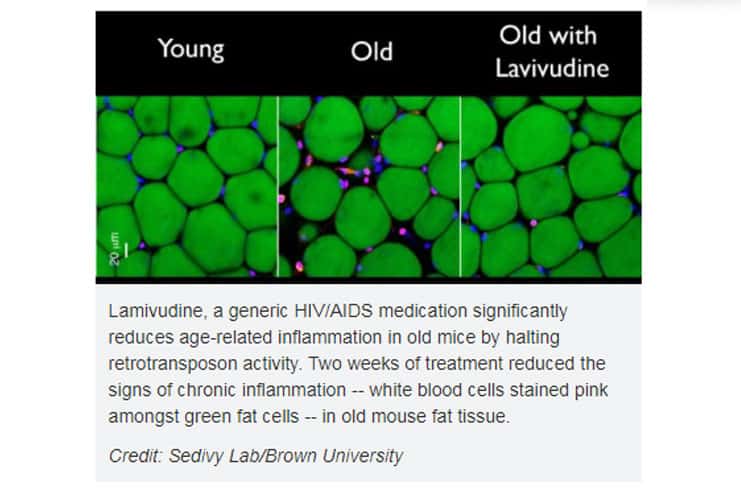Affiliate Disclaimer
Some links in this article are affiliate links. We may earn a small commission if you make a purchase through these links, at no extra cost to you. We only recommend products we find useful to our readersAlzheimer’s or even any other form of age related diseases in humans tend to take a toll on them. But, would you have believed if someone said that a form of HIV medication could have potent impact in treating such conditions?
A new study (R) conducted by researchers from the Brown University have found that blocking out the retrotranspon activity with the usage of HIV or AIDS medication is often quite helpful in reducing quite a fraction out of the age related inflammation that was witnessed in the old mice as well as the senescent human cells.

The study successfully did help in reducing the signs of age related problems one generally face because of aging.
John Sedivy, professor of medical science and biology at Brown University stated saying that the findings are believed to be fruitful in treating age related disorders that many often complain about, including Alzheimer’s. Apart from that, this is also believed to be fruitful in treating the several other associated diseases like Type-2 Diabetes, Parkinson’s, Arthritis and so many more.
This was a collaborative research conducted by the researchers from four different universities namely Brown, New York University, the University of Rochester, Université de Montréal and the University of Virginia School of Medicine. The findings were published in the journal Nature.
Sedivy further elaborated on the topic stating that the administration of the HIV drug was found to have inhibiting activities of the retrotransposon activities in the old cells. Retrotransposons are the DNA sequences in the body which are able to replicate and then move to other places in the body.
Apart from that, they also do have connections with the ancient retroviruses which is left unchecked can often end up producing uncontrolled DNA copies of themselves that can later insert into the varying other parts of the genome. The cells have the capability of keeping these specific jumping genes in check in the early stages of life but that inhibition is gradually lose once the cells start aging.
The team of researchers, in their finding, did find that a specific class of retrotransposons classified as L1, later escaped the normal cellular control and ended up replicating uncontrollably in both the senescent human cells as well as the cells in the old mice. This unprecedented replication was then detected by the interferon response which then finally ends up triggering varying forms of inflammation in the neighboring cells.
Sedivy stated that owing to the fact that these retrotransposons are present in every kind of cells in the body, it is not surprising that they have a unified impact on cellular aging altogether. He further said that the interferon reaction was what turned out to be the game changer in all of this.
The researchers further found that the L1 DNA copies did require the protein reverse transcriptase for replication which is also a requisite for the replication of the HIV and other retroviruses. Majority of the developed drugs for HIV do have impacts on the inhibition of this specific class of protein to aid in the healing or prevention of the disease altogether.
Their main thought was to see if the implemented administration of this class of drug would turn out to be beneficial in treating the condition effectively by inhibiting the viral replication of the L1-retrotransposon activity to then prevent any kind of inflammatory immune response in the body.
The group of researchers administered 6 different types of reverse transcriptase inhibitors to see if it could reverse the impacts for the better. Lamivudine did stand out of them all because of its heighetened activity and lack of side effects in the process.
Sedivy said that when they did administer this specific inhibitor to the old mice, they showcased amazing anti-inflammatory impacts on the cells. Their form of explanation clarified saying that even though the L1s are actually activated relatively late in the senescence, it was the interferon response that that ended up reinforcing the SASP response and ends up contributing to the age related inflammation in the body.
On the administration of lamivudine on the 26 year old mice, it was seen that there were reduced signs of interferon response as well as inflammation in their body. Not just that, the same drug was also administered on a 20 months old mice and was found to induce reduction in the fat and muscle loss as well as reduced the possibilities of kidney scarring in them.
Sedivy did mention the need for more indepth study regarding this owing to the fact that they haven’t mastered every last bit of it. He said that while the treatment with lamivudine did end up helping in reducing the interferon response and inflammation, the effects of it following that doesn’t quite go down after the deed is done with. They are not really well equipped and versed with the whole aging process which is why it is important to have further analysis to understand every last prospect of it.
Sedivy is quite ecstatic about finding out the impacts of the same on the humans. He does want to conduct clinical trials with lamivudine. He stated that these new trials that he is thinking of could be using this specific drug to find its efficacy in the treatment of the age related diseases like that of Alzheimer’s that majority of us face when we grow old. His aim is also to establish a reverse transcriptase inhibitor specifically for the L1.


















